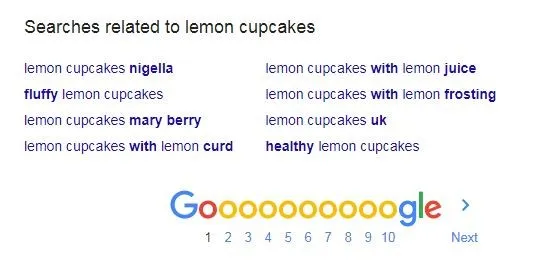The perfect keywords don’t just signpost your content to search. They can be the very reason content is written in the first place. Here’s why:
There’s no point in writing content if no one can find it.
If you’re relying on search to get your content or your business found, you need to use keywords so Google knows what you’re talking about. That way, Google can show your site to the user when they search for your content.
What are keywords?
For the purpose of SEO, keywords are…
words that tell Google what the content is about
words that represent what people are looking for
Killer content contains keywords that sit at the intersection of this Venn Diagram. A perfect balance of satisfying search intent with engaging and valuable content.
Why is keyword research so important?
Keyword research is the practice of finding the terms that people enter into search engines so you can use them for web pages, content creation and marketing.
Researching keywords serves several important functions for content creation. They are an important SEO ranking factor, helping Google to decide how to rank your content.
Keyword research also allows you to find gaps in the public discourse that you can exploit to rank higher than bigger competitors in your market.
Ultimately, keyword research allows you to get into the mind of your audience, helping you anticipate their needs and giving them the information or services they need.
Judging the value of a keyword
Not all keywords are created equally. Part of SEO is all about getting the right visitors to the right areas of your site and keywords are how you achieve this.
When assessing a keyword’s value, first consider whether the keyword is relevant to your page’s content:
Will searchers find what they’re looking for when they land on your page? Will they be happy with it? Will this help convert the searcher into a customer?
All these things need to be considered for every target keyword on every page.
Search the term yourself
Searching a term yourself serves two purposes. First, it shows you the kind of competition you’re up against. It also shows how likely the term is going to result in a conversion.
When searching a term, be realistic about your competition, just like on the high street. If you’re a smaller business, you’re unlikely to compete head-to-head with the sites with serious clout.
But you can be clever and work around this with long-tail keywords (more on this later!)
If your search returns a list of your competitors, you know that the term is probably valuable for you too. You just need to find a way to use that keyword better and their business can become yours.
If the search term returns plenty of search adverts, that tells you the term is a high-value, directly converting keyword. A powerful asset if you can compete.
Take advantage of AdWords
If you use AdWords, you can track the impressions and conversion rate of exact match keywords over time and see how well a keyword converts.
Using AdWords pay per click ads, you can attach a real monetary value to your keyword terms by following the conversion funnel. This will give you a fixed value of your keywords, making it much easier to justify its use in your content.
Keyword types
Keywords aren’t just specific words. They can be phrases too. After all, people searching for “cupcakes”, “pictures of cupcakes” or “lemon cupcakes for sale” all want different things (more on this later).
Long vs. short tail keywords
When researching keywords, it’s important to look at the volume, or monthly frequency. For example, “cupcakes for sale” gets around 26,000 searches a month.
‘Great,’ you’re thinking, ‘I’ll use that keyword and 26,000 people will find me!’
Not so fast, hombre.
Popular search terms like that (what we call short tail keywords) make up only around 30% of searches made online.
The other 70% are “long-tail searches”. Basically, a long tail search is a search query that is longer (surprise, surprise) and can be made up of thousands, even millions of variations.
So “best lemon cupcakes in Covent Garden” might only get a handful of searches per month, but those are some pretty dedicated searchers that The Covent Garden Lemon Cupcake Shoppe can convert easily!
Long-tail keywords are more specific, so have less competition and are more likely to have less content around them. This is also where you can find opportunities for new products or services.
For example, if your keyword research tells you that people are searching for “best coconut cupcakes in Covent Garden”, our intrepid Cupcake Shoppe might see an opportunity to make a new flavour.
Semantic keywords

Today, search engines are clever enough to interpret content based on its context. You can help your primary keywords rank better by supporting them with semantic variations on that keyword.
Semantic search looks at how the words in a search relate to each other and look for clues on how you entered them to provide a more accurate result.
Semantic variations are very important for keywords that can be interpreted ambiguously. The English language is notorious for having verbs that are also nouns.
Take the word “train”, for example. If you train people for a living, you don’t want to waste the time with locomotive enthusiasts.
Semantic keywords help search engines interpret your content, associating words together to show searchers results that they want.
So, in addition to the word “train” adding “teaching” and “training for young people”, will help Google understand that your content has nothing to do with trains. Unless you are a train trainer of some kind…
Keyword intent
Intent Keywords for eCommerce Businesses
- Ratings and reviews
- Comparisons with competitors
- Searches for discounts codes
- Searches for sales
Creating content isn’t just about putting the keywords in place. You need to understand the intent behind the use of keywords in order to deliver the type of content searchers are looking for.
Keyword intent falls broadly into four types: Transactional, investigative, informational and navigational.
Each of these four types of search intent can be tied to the typical sales funnel. If you’re looking to buy cupcakes, you might start by gathering information on the types of cupcakes available.
This usually expresses itself as a simple question: “how do I order cupcakes online?”
While you’re gathering information, you’ll come across some brand names like The Covent Garden Lemon Cupcake Shoppe on a blog talking about cupcake brands. So you type in the brand name to find the URL. This is a navigational search.
Comparing online cupcake store reviews, like Best Cupcakes in Covent Garden, would be an investigative search, as the searcher narrows down their search for the perfect cupcake.
Once they’ve decided that online cupcakes are really what they want, searchers type in a transactional keyword (buy, sell, purchase), along with a specific description.
At every stage of this journey, the content that the searcher looks at needs to match the intent. Information-rich content for informational and investigative searches, more direct, sales-driven content and functionality for transactional searches.
How does search behaviour affect keywords?
People search for things differently than they used to. The most disruptive technology to impact search in recent years is mobile search. This saw an 88% increase in “near me” searches in 2016. The mode of search, therefore, changes search behaviour, and content needs to change as well to match.
Voice search is on the rise. Google Home, Alexa and other Intelligent Personal Assistants (IPAs) have changed the way people articulate their search. Optimising your content for more question-based queries will help increase the chances of your content being delivered by an IPA.
Keyword research tactics
#1 Brainstorming
So where do you even start?
Start with what you know — your business. You know it best, so consider your core offerings, services and unique appeal and brainstorm words and phrases that relate to your business.
Once you have a list, start to value each keyword based on its viability and relevance.
As the list comes together set your short tail keywords to one side and see if you can turn them into long-tail keywords.
So “lemon cupcakes” is a nice short tail key word that can become “lemon cupcakes for afternoon tea” or “lemon cupcakes recipes for vegans” and a hundred other variants. Add those too.
#2 Google Analytics
Next, check out your data. Use keyword tracking software or use Google Search Console to mine your existing keyword rankings.
Here you’ll find lists of phrases used to find your website, which you can use to further build up your list of keywords.
Google Search Console has had a recent upgrade, making it much more valuable as a research tool. You can explore the changes to Google Search Console in one of our recent blogs.
Research can help you predict changes in user behaviour, changes in marketing conditions and even help you develop new products and services.
#3 Go local
If you’re a local business, remember your locational queries. Place names are great modifiers and many businesses relying on local business leverage these keywords to show up in mobile searches.
Remember, to get the most out of local search, make sure your Google Business listing is up to date and set up correctly.
#4 Open your toolbox
The best keyword tools are, of course, ones you pay for. But free tools, like SEMRush’s keyword tracker, can help you see the value and frequency of keywords that you want to rank for.
Google Search Console allows you to see which queries are helping users find your website. You can use these queries as keywords to base new content on.
#5 Related Searches & Suggested Searches
Start typing a search into Google and let it fill in the long-tail keywords for you! Also, check out the suggested searches at the bottom of the search results to see what else people are searching for.
This can really help you add variations to your content. In addition to Google, Soovle and Uber Suggest are useful for this.


#6 Use your intuition
Just because keywords aren’t there doesn’t mean people aren’t searching for them. Long-tail queries can have millions of permutations that aren’t tracked by keyword tracking tools. Despite this, people may be searching for them and you might be able to meet their specific needs with your content.
Also, consider time-sensitive keywords. Do a bit of newsjacking and jump on the trends. If everyone is talking about something that relates to you, you might be able to capitalise on the new search.
The important thing to remember is that time-sensitive keywords don’t get into tracking tools fast enough to show statistic justification, so use your intuition.
Using Keywords in Your Content
So now you’ve got your keywords. How do you deploy them into your content?
Step 1: Pick your primary keyword
Step 2: Decide your secondary keywords
Step 3: Work out your semantic variations
Step 4: Create content!
Some people say that there’s a fixed number of keywords you need to include in any piece of content. There is no magic number.
The mantra Google never seems to stop repeating is “great content”. To Google, great content is unique, provides value to the user and is supported by semantics and a context that meets the user’s search intent.
Great content is what ranks, so produce great content.
Write well, write informatively and write in a way that is digestible. Write like a human being, not a keyword robot. Do more than writing! Produce content that explains things in an engaging way, using interactive elements, imagery and video too.
Sprinkle your keywords naturally throughout the body of your content. To help Google out a bit, make the most of your web page’s title tag, meta description and headings. These act as signposts to help Google understand the content.
Finally, don’t forget your image alt-text. Alt-text helps users with vision impairment make the most of your imagery, making your content much higher quality from a user perspective.
Title Tags
Title tags are STILL the single most important place for keyword targeting. Your primary keyword should be in here, as close to an exact match as possible. Also remember that your title tag is also often what appears in search results, so make it appealing at the same time.
There’s a lot going on with title tags, so you can find more information here.
Meta Description
This is your tweet-long hook. Your elevator pitch for clicks. You can do lots of clever things with meta descriptions to get people to click and again, remember your keywords.
Note that meta-descriptions aren’t ranking factors. First and foremost they should encourage clickthrough. But by including your keywords you can help users understand your content because they are highlighted, like so: *Googles SEO Agency Hampshire*

As you can see in this shameless plug, we have the words “Hampshire”, “SEO” and “Agency” in our meta. This doesn’t help our ranking, but reinforces to searchers that we do SEO and we’re in Hampshire.
Headings
<h1>THIS IS REALLY IMPORTANT PAGE REAL ESTATE</h1>
Your H1 heading is the title of your page and helps Google and your searchers know what’s on the page. H1s are where the perfect blend of keywords and user experience has to happen.
So now you know how to pick the perfect keywords for your content. All you have to do now is write some great content.
Have fun!






